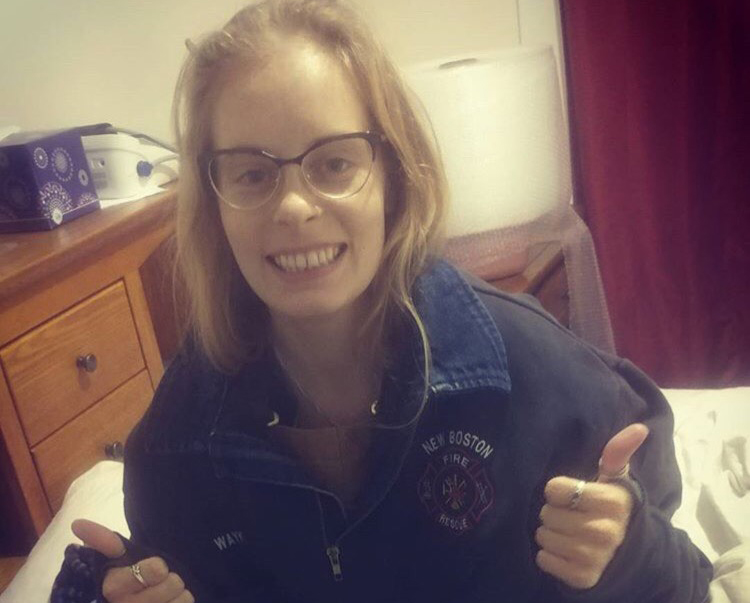Living with Lyme
New Hampshire continues to be plagued by Lyme disease which affects thousands in the state each year. Twenty-eight-year old Ashley Lynch, a former Goffstown High School student is currently undergoing treatment at Envita Medical Center in Scottsdale, Arizona to fight for her life.
It began in Ashley’s first two weeks of life and although she was unaware at the time, ear infections were the earliest signs. Ashley’s mother, Amy Lynch, explained they knew Ashley needed medical attention after she started falling out of bed. Doctors assumed it was viral and ordered blood tests to determine a diagnosis. The results discovered that Ashley had high cholesterol for an infant, and was sent to Boston’s Children Hospital. Today, high cholesterol is known as one of many signs of Lyme disease. Doctors tested Ashley for Lyme and all results came back negative. Now data shows that up to 49% of tested patients receive false negatives. The patient could have the infamous bull’s-eye rash and receive negative results.
Ashley has received five back surgeries, along with spontaneous spinal cord leaks with no explanation. After graduating in 2015 at Columbia University, she spent less than a year as an occupational therapist before she began to experience mental fogginess. Amy Lynch reveals that “It was so severe that Ashley could not remember traveling to work and could only get herself out of bed before experiencing memory loss.” Ashley explains the health issues have occurred her whole life and are not all individual illnesses but one single illness that the doctors misdiagnosed due to negative Lyme test results. Based off her experience Amy feels that, “they don’t dig deep…they want to treat the symptom, not the Lyme.” When Ashley was hospitalized, her neurologist told her that it was all in her head. Another doctor misdiagnosed Ashley with anxiety, that night Ashley ended up in the ER with a spinal cord leak. “To ever feel this way, Ashley explained, to be scared to ask for something for pain or just seeking help, and not getting it from the people you think can provide it best is scary”. Ashley worked in Elliot Hospital for less than a year before her condition worsened. Within her time there she “would hear all the time…ugh that’s such a buzzword right now, Lyme disease. Everyone thinks everyone has Lyme now”. Many doctors are misunderstand the reality of Lyme and believe its curable with 20 to 30 days of doxycycline, but this is not necessarily the case. What most people do not know is Lyme disease can lie dormant in the body for years until it finds a weak spot to attack in the victim’s body. Nick Dupuis, a doctor employed at Maine Medical Center explained that “they complete testing only if there is a high suspicion for Lyme and they could only miss the diagnosis if no tests are completed.” This raises questions around how and why Ashley was misdiagnosed, considering she was tested as an infant.
Before Ashley’s condition worsened, she planned that Envita was where she needed to be. Ashley “knew the clinic would save her life.” Ashley and her boyfriend Eddie Barrera sold everything they had, from their tables to their cars, to get to Arizona for extensive treatment. Financially, it is a struggle to get reliable treatment for Lyme disease. Envita estimates the price for treatment to be $101,000 for only three months without insurance coverage. Amy worries that it “could be beyond that because [Ashley] is pretty far gone in Lyme stages. Amy says they are overwhelmed and honored with the fundraising that is happening within their community and “without it she wouldn’t be able to be at Envita and that’s where she needs to be to live.”
The Envita doctors explain that the Lyme was probably something that was passed through blood before she was born. Now, Ashley has infections within her body because of the Lyme bacteria. Doctors at Envita say they have never seen anything like the amount of bacteria in her stomach. Ashley has five strands of candida in her GI system, along with both rare strains of bartonella and other infections. Ashley’s mother says Ashley’s “body is pulling from anywhere it can to survive but there is no good bacteria for her body to take from.” The Lyme has invaded Ashley’s neurological system which affects her cognitive abilities such as memory, organization, and her brain’s ability to send signals to the rest of her body. Since her brain and body are on two different wavelengths, Ashley’s ability to speak, walk or perform any of the basic actions she needs are seriously affected.
At this point in Ashley’s treatment the bad bacteria in her body are dying off, the technical term for it is herxing. When herxing occurs, bad bacteria in the body explodes and releases endotoxins,which makes patients extremely sick. The body needs to be detoxed through this process which she did not know before. As the bad bacteria was dying off, it was released and trapped inside her body due to the lack of detoxing. Over time, this bacteria would have traveled into her heart which could have been fatal if she did not seek medical attention at Envita.
Severe symptoms also include chronic depression and anxiety, but through it all, Ashley continues to have a positive attitude and says, “at the end of the day I feel more hopeful than depressed.” Ashley hopes to use her condition as a way to educate and spread awareness around the reality of Lyme disease. “It’s crazy how hard it is to get a diagnosis, how poor the resources are, especially in New Hampshire, and that this still happens today. It’s just wrong but we’re here and we’re fighting and we’re gonna do something about this…we all are.”








